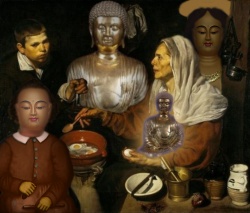The myth of dog-eating in China
Eating dog meat is not a Chinese tradition and the Yulin “dog-meat” festival is just a money-making scheme carried out under the banner of culture, argues Hu Yifu.
There is a misconception among some that China has always been a dog-eating nation.
The growing popularity of eating dog in China is due mainly to prominent depictions of the practice in the film Shaolin Temple and a popular historical TV show about a monk, helped by over-promotion by some restaurant-owners and local governments.
The recent controversy over the “dog-meat” festival in Yulin, a city in south-west China’s Guangxi province, is awkward for the local government. Officials first stirred up the debate to promote the importance of the festival, claiming it supported local culture while boosting the local economy.
But the local government never expected that its commercial activities would come under pressure from dog lovers around the country. It was forced to quietly claim that the whole affair was run by local businesspeople in an attempt to avoid responsibility.
China’s history of dog-eating
Dogs have been a part of Chinese households for at least 7,000 years, archaeologists say.
The mythological ruler Fu Xi was said to have domesticated six wild animals: the pig, ox, goat, horse, fowl and dog, indicating that dogs were often kept even in ancient times.
Records show that back then dogs were kept mainly to assist with hunting.
As the Chinese people became more engaged with agriculture, the dog’s role as hunter became less important – but it was not cast aside. Its loyalty to its owner made it valued for its role as a guard.
Those who advocate the eating of dog maintain it is a Chinese tradition, claiming that historical documents tell of “dog butchers” who specialised in preparing the meat.
Others quote from works by founder of the Han dynasty Liu Bang and Qing dynasty painter Zheng Banqiao as proof that the Chinese have always enjoyed dog meat – but this is not enough to prove it is a tradition or custom.
The San Zi Jing, a text used to teach children since the 13th century, describes dog as one of the six animals raised by people.
This is generally taken to mean that these animals were a source of meat.
But as agriculture developed and eating habits changed cows, sheep, chickens and pigs became the main sources of meat for Chinese people. Dogs gradually stopped being used as food – and the reasons behind this are complex.
Prior to the Qin and Han dynasties the combination of primitive agricultural techniques and the chaos of constant war meant that living standards were low and meat a rare luxury, offered primarily to the elderly as a sign of respect.
Beasts of burden and guard dogs which died of illness or old age could not be wasted, so our thrifty ancestors would cook the meat and eat their fill.
Dog meat was not an essential food for people, as can be seen from a study of sacrificial offerings.
These offerings to the gods and their ancestors were important and great attention was paid to the goods to be offered.
For the grandest of imperial ceremonies a cow or horse would be sacrificed, for less important occasions a pig or sheep, and the ordinary people would offer pork, chicken or fish.
But dog was almost never used, and it was regarded as disrespectful to the spirits to do so. That taboo is still common today, showing that dog meat is not suitable for refined tastes, and certainly not for serving to guests.
Dog fell increasingly out of favour after the Han dynasty.
Philosophical Taoism, which rose in the late Han, saw dogs as unclean and consumption of dog was believed to harm efforts to live a simple life.
During the Tang and Song dynasties dog consumption decreased further as the range of available meats increased and stories of faithful dogs and Buddhist ideas of reincarnation spread.
China has many ethnic minorities, each with its own traditions and culinary customs.
But none of them can be described as dog-eating.
In Islam dogs are regarded as unclean and so there is a religious prohibition on eating dog meat. Mongols are traditionally nomads and see dogs as guards and staunch companions.
For Manchus eating dog is taboo, due to a legend that a dog saved the life of their forefather Nurhaci.
The Tibetans are Buddhist and will not kill animals unnecessarily, and see dogs as loyal companions, so rarely eat them.
And even the Zhuang people of Guangxi – where the Yulin “dog-meat festival” takes place - are not recorded in historical documents as being keen dog eaters.
All about the money
Local government officials are evaluated by their superiors on GDP growth.
But remote and poor regions struggle to meet these growth targets, and the officials responsible are under considerable pressure.
This gives rise to various odd money-making schemes, with cultural events designed to boost the local economy a popular choice.
Yulin, situated in China’s south-west border province of Guangxi, has never been a part of mainstream Chinese culture and has no famous historical figures or events to make use of.
So people scratched their heads and came up with a ”dog-meat and lychees” tradition to attract tourists and investment.
Dog-eaters have, naturally enough, any number of reasons to explain the legitimacy of the practice, going as far to defend its legality by pointing out that anything not banned by law, is permitted.
But have they thought that there are moral standards as well, higher than legal ones? Or our own standards as human beings, higher again?
Legal standards are designed to protect our basic security.
Moral standards maintain our civilisation and ensure we do not tend towards the degenerate. And our own standards push us forward to achieve more.
While the dog-eating advocates argue the reasons for their case, have they considered the shock and horror of the ordinary people seeing dogs slaughtered in the streets of Yulin?
Source
https://www.chinadialogue.net/books/7175-The-myth-of-dog-eating-in-China/en





